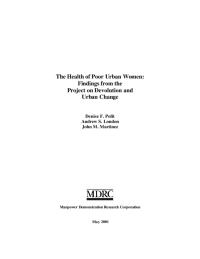The Health of Poor Urban Women
Findings from the Project on Devolution and Urban Change
To what extent might the health of welfare recipients and their children play a role in the new welfare environment? In 1996, Congress passed the Personal Responsibility and Work Opportunity Reconciliation Act (PRWORA), creating a five-year lifetime limit on the receipt of federal cash welfare benefits for most families. PRWORA dropped the language from prior legislation that excused welfare recipients from mandatory participation in welfare-to-work activities for health reasons. The new policy considers all recipients subject to participation requirements and time limits, except for an undefined 20 percent of each state's caseload who may be excused for "good cause." There is little information about whether the 20 percent figure is sufficient to encompass all recipients with health problems - or whether women leaving welfare will be able to secure the health care they need for themselves and their children.
This report describes the health and health care needs of welfare recipients (and former recipients) living in large urban areas, where a substantial percentage of the national welfare caseload lives. The report is based on 1998-1999 survey and ethnographic data from the Project on Devolution and Urban Change, a multi-component study designed to examine the implementation and effects of PRWORA in four urban counties: Cuyahoga (Cleveland), Los Angeles, Miami-Dade, and Philadelphia. Survey respondents were selected randomly from among the May 1995 public assistance recipients residing in high-poverty neighborhoods in each county. The report compares the health of four groups of women based on their statuses at the time of the survey: women who had left welfare and were working, women who combined welfare and work, women who received welfare and did not work, and women who neither worked nor received welfare. Ethnographic interview data, collected from welfare recipients living in selected neighborhoods in each site, complement and augment the survey findings.
Among the key findings:
- The women (and their children) had substantially higher rates of physical and mental health problems than did national samples of women and children - and their health problems were often multiple and severe.
- Women who worked (especially if they had left welfare) were in much better physical and mental health than those who did not work.
- Nevertheless, working women who had left welfare often lacked health insurance and still experienced substantial physical and mental health problems, as did their children.
- The high prevalence of health problems among women who were still receiving welfare suggests that there will be major challenges to welfare agencies as a growing number of recipients face time-limit pressures.
- Women with multiple health problems (and women who had been physically abused) were more likely than other women to have been sanctioned by the welfare agency in the previous year.
- Welfare leavers who were not employed had the most compromised health situations: They tended to have high rates of health problems, lack insurance, and experience high levels of unmet need for health care.
Women's health problems and those of their children likely constrain women's entry into the workforce and their ability to remain there. Additionally, health problems compromise women's ability to comply with participation requirements, which raises questions about current sanctioning policies. Given the health care needs identified in this study, an especially critical policy challenge is to develop mechanisms to ensure that women who leave welfare maintain health insurance.






